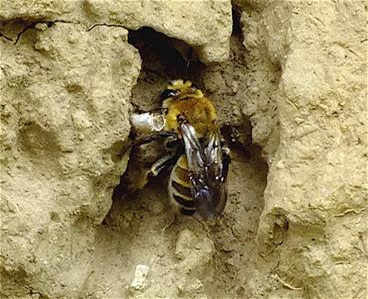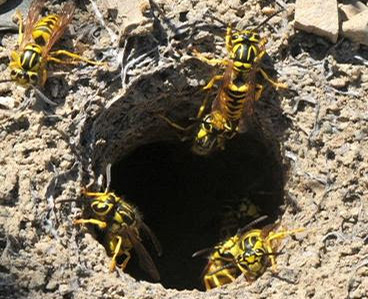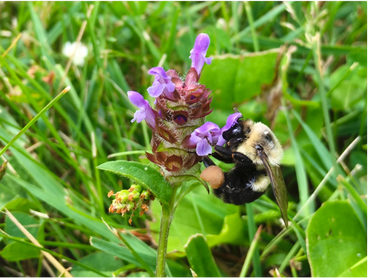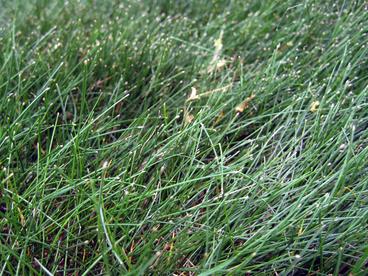Planting and Maintaining a Bee Lawn
University of Minnesota Extension. https://extension.umn.edu/landscape-design/planting-and-maintaining-bee-lawn
While turfgrasses can provide some environmental benefits, they don’t provide much food for pollinators.
One way to provide resources for pollinators while keeping the function of a lawn is to incorporate other plants such as dutch white clover, self-heal and creeping thyme. These plants have the right type of flowers for bees.
Once established, bee lawns take a similar (or even less) amount of work to maintain as a traditional lawn, making them an accessible addition to almost any home landscape.
Plants for a Bee Lawn

There are lots of plants that bees like, but few are adapted to lawn conditions. Not many plants besides turfgrass can tolerate being mowed short and stepped on. Here are the traits needed for bee lawn flowers:
- Low-growing and adapted to being mowed.
- Flower at low heights.
- Tolerant of foot traffic.
- Provide good food (nectar and pollen) for pollinators.
- Moderately competitive, meaning they can hold their own with the turfgrasses without taking over.
- Have a perennial life cycle (they live for more than one year) so they are maintained in the landscape with the perennial turf.
As one of the few native plant species adapted to lawn conditions, self-heal (Prunella vulgaris spp. lanceolata) is a great plant for bee lawns. Its purple flowers bloom throughout summer and attract a wide variety of pollinators. As a native species, it is great for attracting native bee species. In fact, researchers found that native bees comprised 95% of the visitors to self-heal flowers.
Turfgrasses for bee lawns also need certain characteristics that make them compatible with the flowers. Fine fescue species are recommended for bee lawns because of their low fertilizer, irrigation, and pesticide requirements. They are also capable of growth among bee lawn wildflowers. Fine fescue mixes typically include strong creeping red fescue, slender creeping red fescue, chewings fescue, hard fescue, and sheep fescue.
Establishing a Bee Lawn
First, your lawn should be prepared to be seeded with a bee lawn seed mix. If your lawn does not have a lot of weeds, you can typically directly seed your lawn with a slightly higher seed rate. However, if your lawn has a lot of weeds you will want to remove them before seeding. There are a few weed removal techniques you can utilize, including solarization (covering your lawn with a plastic layer to kill the weeds beneath it), herbicide application, and hand weeding.
Once your lawn is properly prepared, you can spread the seed. It is best to seed your lawn during late fall, so that seeds can germinate earlier in the spring and better compete with spring weeds. You can also seed your lawn in late spring (late May-early June) after the risk of frost has passed.
For a detailed explanation of site preparation, check out the Xerces Society's guide!
Maintenance
Once your seeds have germinated and your seedlings are established, you should not need to irrigate your bee lawn. Choosing a fine fescue turf mix will also lower your lawns water requirements. As your lawn grows thicker, mowing can be good to reduce weed pressure and support additional blooms. Overall you'll want to mow less frequently than in a typical lawn, and at a higher cutting height. Additionally, you can compost your lawn clippings or rake them directly over your lawn to recycle the nutrients back into the soil (but be careful not to smother your lawn).
Weed maintenance is also incredibly important, particularly during the early stages of your bee lawn. Hand weeding is the best strategy, and herbicides should generally be avoided to protect non-target species. However, if you choose to apply an herbicide there are a few things to keep in mind: avoid spraying when flowers are in bloom, when pollinators are active, and spot treat the affected area.
Ground nesting bees: Are they a threat to your lawn?
Ground nesting or miner bees are solitary bees that create underground galleries, with queens living individually and raising their own young. The entrances to the nests are small piles or patches of bare soil. They do not form hives, but several females may nest in the same area. Ground bee queens do not defend their nesting areas and are very docile and unlikely to sting, posing little or no threat to people. The males often patrol an area inhabited by females seeking mates. While the males can be very active and seem aggressive, they lack a sting and are also harmless. Like other bees, they are active foragers of nectar and pollen from flowers, making them beneficial pollinators.
Their nest entrances are small mounds of soil a few inches across. While they may briefly detract from the aesthetics of a well-tended lawn, they do absolutely no harm to the grass or soil - even improving it as their nests function as aeration holes, improving the penetration of water and nutrients. Eventually, as the nests are abandoned after the spring nesting season, the soil washes back into place with rain, disappearing completely.
If you feel you must get rid of ground bees even for the brief time they live in your lawn, there is no need to use pesticides of any kind. Ground bees prefer dry soil to nest in, and simply watering the area that they have chosen will cause them to move to another area. If you find ground nesting bees return to your lawn in large numbers year after year, run a sprinkler on the area before they show up; ground nesting bees prefer dry soil to wet soil and will look elsewhere to make their nests.
Make sure that you are evicting ground bees and not yellow-jackets. Yellow-jackets reaction to a water eviction will not be “non-aggressive” by any means. A yellow jacket nest will look like a busy airport with many insects entering and leaving in a constant stream, and entrances can be well over an inch wide. Only one ground bee will be seen leaving and entering a hole only about ¼” wide.


Wildflower Lawns
Kernow Ecology. Invertebrate Survey and Conservation. http://www.kernowecology.co.uk/beelawns.html
It is possible to create great short grass areas for bees suitable for you to sit or lie. The Pea family (Fabacea) in particular are very important bumblebee forage and both Birdsfoot trefoil and Red clover can create very attractive low maintenance lawn areas in a garden.
The best management for such an area is mowing and removing the clippings throughout Sept to March keeping as a short lawn. Whilst between April to Sept cutting a bit higher and leaving for a few weeks to flower and set seed either areas within the lawn or particular plants. You can time the cuts depending on the species you wish to flower and set seed. This obviously does work better if you can come to terms with a less formal lawn. In my experience the lawn in summer can be kept slightly taller than a normal lawn, which allows the plants to flower, and for you to lie on top of the flowers without damaging them.
Another way is to have a spring meadow/lawn leave it uncut between late March and June then cut as a short lawn outside these times. This works particularly well in Devon and Cornwall it also results in a lawn probably more acceptable for an obsessive gardener.
| Red clover | Trifolium pratense | Native, Best plant |
| Self heal | Prunella vulgaris | Native, Tough and good forage |
| Germander speedwell | Veronica chamaedrys | Non-native, Tough better for solitary bees |
| Slender speedwell | Veronica serpyllifolia | Non-native, Tough better for solitary bees |
| Autumn hawkbit | Leontodon autumalis | Non-native, Tough better for solitary bees |
| Mouse-eared hawkweed | Pilosella off. | Non-native, Tough better for solitary bees |
| Kidney vetch | Anthyllis vulneraria | Non-native, Good bee plant but untested in a lawn? |
| For poor soils: | ||
| Wild thyme | Thymus vulgaris | Non-native, Best plant |

